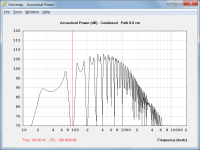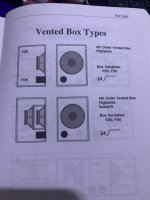Agreed. As far as I can see all existing video tutorials, manuals, etc relating to Hornresp are out of date one way or another. The older ones can indeed be quite misleading as things have changed so much over time. Also, it would be necessary for you to arrange a server to host your Help application.
Somethings are unlikely to change (like the main screen which has been the same for as long as I can remember), but that doesn't mean that functionality of an existing feature can't change behind the scenes, or new features added. I have been purposely looking for newer tutorials because of that very reason. I found a half decent one in Portuguese but it wasn't good enough to share with everyone. There is a distinct lack of really good training videos on the subject, some people seem to understand it well enough, but just because you understand it doesn't automatically make you a good teacher. There is an art in explaining concepts. Now that I can look at the help instructions without my head exploding I am going to try and tackle it bit by bit. Not guaranteed that I will understand it, but at least I will get some basics from it.
Now that I can look at the help instructions without my head exploding I am going to try and tackle it bit by bit. Not guaranteed that I will understand it, but at least I will get some basics from it.
Excellent!
Also try experimenting with the Input Wizard.
Been experimenting with the wizard (both the input and the speaker) and some things are starting to fall in place. This is essentially a BR box with an added horn (that part isn't so much the revelation I knew that). But what I have discovered changing a few parameters around is this is still the same BR box that I did in the lower boxes with the horn section added in the upper boxes. So the basic chamber size and length and port information is still be derived from the same source, we have just changed the box type by adding the horn part and the additional upper box parameters.
So the basic chamber size and length and port information is still be derived from the same source, we have just changed the box type by adding the horn part and the additional upper box parameters.
Exactly - you've got it.
Just be aware that for some of the more complex loudspeaker systems, the purpose of an input parameter box can change. The label will be different, and moving the mouse pointer over the input box will show in the status panel at the bottom of the Input Parameters window what the value represents.
Hornresp is not just a "one trick pony" - it can be very powerful, versatile, and flexible when it needs to 🙂.
It's the best modeling program for bassheads, PERIOD!
Looks like a vented FLH which would turn the BP4 (FLH) to a BP6P.Yes but I first need to know what each of the boxes are called, and what parameters are needed to model them to get the most out of the wizard. Again this is where pictures would really come in handy. I spotted this box design while searching for Hornresp tutorials last night, but I have no idea what it would fall under in the myriad of different box names I have never heard of seen before.
View attachment 1284126
Not sure if this was discussed previously, but it would be interesting to know if and how hornresp deals with delay related issues (such as comb filtering) in back loaded horns.
Or if this has to be addressed by aiming for a narrow enough frequency reinforcement in the power response, to happen in phase with the direct radiation of the driver, and based on the length of the horn (i.e. time delay of the rear horn emission vs front emission of the driver).
For example a 3.4 meters long BLH ideally results in a reinforcement due to constructive phase interference at 100hz with the direct radiation of the driver, and a cancellation due to destructive phase interference at 50hz against the direct radiation of the driver.
Or if this has to be addressed by aiming for a narrow enough frequency reinforcement in the power response, to happen in phase with the direct radiation of the driver, and based on the length of the horn (i.e. time delay of the rear horn emission vs front emission of the driver).
For example a 3.4 meters long BLH ideally results in a reinforcement due to constructive phase interference at 100hz with the direct radiation of the driver, and a cancellation due to destructive phase interference at 50hz against the direct radiation of the driver.
For example a 3.4 meters long BLH ideally results in a reinforcement due to constructive phase interference at 100hz with the direct radiation of the driver
It will result in a cancellation rather than a reinforcement at 100 Hz because of the 180 degree phase difference between the front and rear sides of the driver. Adding a one wavelength delay to the rear side of the driver does not change that difference. Hornresp takes all of this into account when calculating the combined power response, as shown in the attachment.
Attachments
Is loaded when the S1 is less than Sd?Looks like a vented FLH which would turn the BP4 (FLH) to a BP6P.
Is loaded when the S1 is less than Sd?
It would still be considered to be horn loaded even if S1 was greater than Sd.
So what makes it horn loaded? Whenever a horn is attached?It would still be considered to be horn loaded even if S1 was greater than Sd.
Starting to get the hang of all these letters and numbers. BP4 or FLH is a sealed chamber at the back with a horn on the front, whereas adding a port to the rear chamber turns it into a 6th order band pass. Because the horn on the front is viewed as a tuning port (just a very big one). What is the P in BP6P (ported?)Looks like a vented FLH which would turn the BP4 (FLH) to a BP6P.
So if you flipped the driver it would become a BLH, but still be a BP4 (if the horn was missing).
What is the P in BP6P
In BP6P the second P stands for parallel. In BP6S the S stands for series.
BP6P - Sixth order parallel band pass loudspeaker
BP6S - Sixth order series band pass loudspeaker
Generate one of each using the Input Wizard to see the difference.
Will do just trying to knock so code out at the moment. Buying some shares has opened up a can of development worms.Generate one of each using the Input Wizard to see the difference.
Ok, sorry, I didn't take into account the phase invertion on the back of the driver, nonetheless the power response you posted clearly shows comb filtering, which is my worry. How is one supposed to deal with that ?It will result in a cancellation rather than a reinforcement at 100 Hz because of the 180 degree phase difference between the front and rear sides of the driver. Adding a one wavelength delay to the rear side of the driver does not change that difference. Hornresp takes all of this into account when calculating the combined power response, as shown in the attachment.
I've come across this project from Joseph Crowe where FR shows indeed.a dip which could be due to phase cancelation at 80hz, still in the THD graphs this dip is gone and reading through the description he says that dip only exists with a specific mic placement. How can this be ?
Should one be concerned about comb filtering when designing a BLH or not ?
https://josephcrowe.com/blogs/news/15-back-loaded-horn-no-2095
A flipped driver in a BP4 is still a BP4. The speaker basket (flipped driver) in the vented chamber aids in voicecoil cooling.So if you flipped the driver it would become a BLH, but still be a BP4 (if the horn was missing).
BLH or RLH are nothing more than a BR enclosure with a positive flare port. See Scoops. When the driver is in the horn's path, then the enclosure acts like a TH. So, you can model certain BLH/RLH's with the TH function in HR.
BLH/RLH
BLH/RLH that can be modeled as a TH with a compression chamber.
Sealed = 1st order.Starting to get the hang of all these letters and numbers. BP4 or FLH is a sealed chamber at the back with a horn on the front, whereas adding a port to the rear chamber turns it into a 6th order band pass. Because the horn on the front is viewed as a tuning port (just a very big one).
Bass Reflex & Transmission Line = 2nd order.
FLH & BP4 = 4th order.
TH, BP6S, BP6P, Keystone, SS15, THAM, ROAR, Paraflex, Devastator = 6th order.
BP8S & BP8P = 8th order = 6th order enclosure firing into a BR enclosure.
Last edited:
- Home
- Loudspeakers
- Subwoofers
- Hornresp


